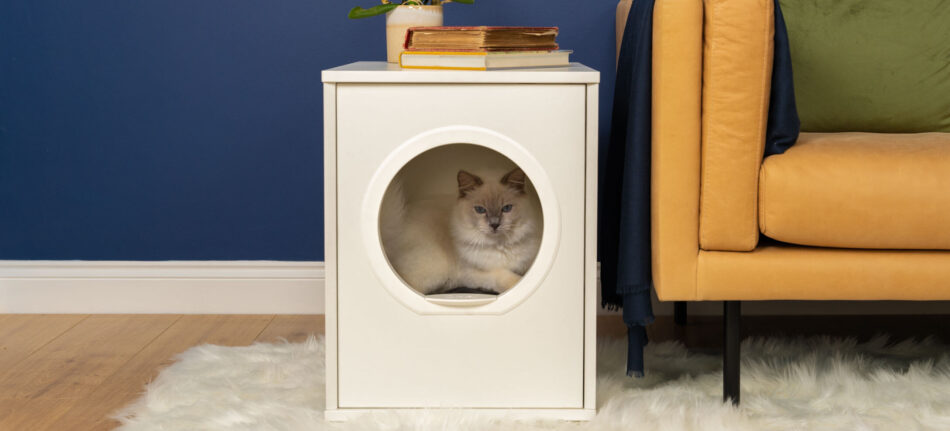Top tips for moving with cats
Whether your cat is moving with you to a new house or you’re welcoming a new cat into your life, a new home can be stressful and confusing for our feline friends. The first few days are especially trying, and it’s important that you as an owner do everything you can to make the move as smooth as possible for your pet. Read on to find out some top tips for moving with cats.
Table of Contents
Moving to a new place with a cat – before the move
If you are moving with a cat, try to keep the cat’s routine as normal as possible in the days leading up to the move. Very anxious and timid cats will benefit from familiarizing themselves with cardboard boxes around the house before you start packing your belongings.
In the new house (or your current home if you’re rescuing a cat), prepare a room somewhere where you can keep your cat when you arrive. This should ideally be a spare room or a bathroom away from the hustle and bustle of the home. Cats will naturally think a new house is scary and smells unfamiliar, so giving them a smaller space to get familiarized with to start with can be less difficult.
Give your cat places to hide in the room, as well as a snug spot to relax, maybe with something they already feel comfortable with, like their super comfy donut cat bed or a blanket from the rescue centre. Also prepare a cat litter box, bowls with food and water, and some toys.
A Freestyle cat scratching tree that is tall and rigid will also help your cat let off some steam and allow them to leave familiar scents from glands in their paws, which will help them keep calm.
If possible, prepare this room with everything your cat needs before bringing them home.
During the move
The most important thing when getting a cat to settle in a new environment is to have patience and always let your cat make the first move when it comes to approaching new things, or new people. Most cats love feeling in control, and by pulling them out of the cat carrier or picking them up for a cuddle you could be adding to your cat’s stress.
Be aware that it might be a few weeks, or even months, before your cat feels comfortable in their new home. It takes them time to get used to new surroundings, not to mention other cats or children they’ve never encountered before.
If possible, it’s good to give your pets something familiar that makes them feel safe. If you’re adopting a cat, ask the adoption centre if they have a blanket or toy your new addition has been using, or if you’re moving house with your resident cat, unpack their things first. Don’t change the food you’re giving them, give them a new litter tray or treat them to a new bed just yet.
How to introduce cat to new home
Make sure the space where your cat is allowed to be is completely cat proof. This might, to start with, just be one room, but if you’re letting your feline friend explore the whole house, keep all doors and windows closed, and check potential cat flaps or even chimneys before you invite your cat in. Give everyone around on moving day careful instructions or put a sign on doors to inform them where the cat is. The new home will seem like an unsafe space for your pet, and their instinct will most likely be to escape.
Once you have set up a room or an area for your cat to initially settle into, carry the cat into the room and open the door to the cat carrier. Sit back and see what they are doing, but never force them to come out or pick them up, let them explore in their own time. You can sit in the room, or you can leave for a bit and come back later.
When you have seen that your cat is comfortable in their room you can open the door and allow them to come into the rest of the house whenever they feel ready. Cats are naturally inquisitive, so they will want to explore their new surroundings.
If you have other animals or pets in the house that your new cat has not met before, make careful introductions i.e. initially using a barrier, keeping a distance. You should try to space out any stressful events to not overwhelm your cat.
It’s normal for a new cat, or a cat in a new home, to not have much of an appetite or to cry during the first few nights. Unless you think it might be detrimental to your cat’s health, or that they are in danger, leave them to it. Most cats will stop this behaviour after a couple of days.
Transporting your cat to a new home
Make sure you have a good pet carrier that is big enough for your cat. If you can, it’s a good idea to get your cat used to car rides before the journey to a new home, but that is obviously more difficult if you’re picking up a rescue cat.
Put some soft bedding in the carrier and secure it in the trunk or with a seat belt inside the car. It’s important that it’s safe and doesn’t move around, as that will be very stressful for your cat. Regulate the temperature in the car so it’s cool but not cold.
Keep the journey as short as possible; don’t make any unnecessary detours or make stops you don’t have to make. If you do need to stop, it’s often best not to let the cat out of the carrier, as there is a risk they will escape. However, never leave your cat unattended in the car. It can quickly get dangerously hot, fast.
Moving a long distance with cats
If the journey is so long that you will need to stop and allow your cat to go to the toilet or eat and drink, it’s important you find a place where it’s safe to do so. Consider keeping your cat on a lead, or only let them out in a confined space. If you’re travelling really far you might want to sedate your cat to make the journey less stressful for all. Speak to your vet to see if this is an option.
When to let your cat outside
If you have a cat that normally spends a lot of time outdoors, you might want to let them out as soon as possible and give them their freedom back, but it’s generally good to keep a cat indoors for at least a few weeks. Moving is one of the most common reasons cats disappear, be it because they don’t feel safe in their new house or that they get lost, so be careful. You can read more about this in our previous blog post Why Do Cats Run Away?
Moving house with an outdoor cat
While keeping outdoor cats indoors, make sure they have plenty of stimulation and exercise opportunities.
Once you think your cat is ready to go outside, one thing you can do in preparation is to sprinkle a bit of used litter around the perimeter of the yard. This will make the outside space smell familiar to your cat, and other cats in the neighbourhood will be warned that there is a new cat on the block.
The first times you let your cat out, make it short, and keep an eye on them. Call them back after a few minutes, and gradually extend the time they spend in and around the yard. It’s best to stay with them to reassure them that everything is fine, and leave the door or cat flap open so they can return into the house if something scares them.
If you have moved somewhere that doesn’t allow your cat to roam as freely as they have previously done, be it due to traffic, wildlife or neighbours, you might want to consider investing in an Outdoor Cat Run. Omlet’s catios lets your cat feel the wind in their fur in complete safety, and they can keep your cat healthy and fit without the worry of them running away or getting hurt. There is also the option of a Cat Balcony Enclosure if you live in an apartment.
Moving house with your cat
While lots of these tips apply to a new cat as well as a long term pet who is moving with you, there are some specific things that could help a current cat settle in.
As your cat has been living with you, there are things that will be easier than bringing home a new cat. Maybe they have a Maya Indoor Cat House or Memory Foam Bolster Cat Bed where they can go for some quiet time and that will immediately make them feel at home. If you want to introduce your cat to a cat house, this might be a good time, as they will be searching for a safe space to retreat to. You can read more about this in our previous blog How to Get a Cat to Use a Cat House.
Depending on their personality, you will probably want to let them out of their initial introduction room quite quickly. They are used to being around you and your family and keeping them separate can be more stressful. But again, wait for them to make the move.
One thing to help your cat adjust can be to take a piece of cloth and rub it gently around your cat’s neck and face to pick up their scent. You can then wipe this cloth on furniture in the house at cat height to make the new territory seem more familiar. Feliway products or a pheromone diffuser can also be good options.
Remember to update the address on their collar and change their microchip information on any database.
If you haven’t moved far, there is always the worry that your cat may disappear in search of their old home. Sometimes the new owners will provide food and leave out water bowls for the unexpected visitor, so, if possible, ask the new residents to let you know if your cat shows up. To avoid these trips down memory lane, keep your cat indoors for the first few weeks after the move. That won’t necessarily make them forget their old home, but should get them used to their new one, and hopefully realize that’s where they belong.
Moving with multiple cats
If you live in a multi-cat household, then this can inevitably make things a little bit complicated, but with the right preparations, the move can be made as stress free as possible! The process of moving itself isn’t all too different, but you will have to consider the needs of more than just one animal. Take a read of our How to Create Peace in a Multi Cat Household blog for some advice on creating a better dynamic between your cats, which will help in making the transition easier when the time comes.
Conclusion
A move is a very exciting event for both cats and humans, especially for those who are moving from a shelter to their forever home. However, most animals are creatures of habit, and many cats find a new house a very scary thing. To make the move a bit more comfortable, shop Omlet Cat Products to help you find everything your purry pal needs to settle into their new home. Make sure you prepare yourself for the next few days, or weeks, to be a bit tiring. And with these tips for moving with a cat, it will, of course, be worth it in the end!
This entry was posted in Cats



One reply on “Top tips for moving with cats”
When we moved, we always put a little butter on their front paws.As soon as we entered the house we would put the cats’ in their beds, and they would sit there licking the butter off their paws’ and it would settle them straight away. My Mother use to do it to our cats’ when we were young .